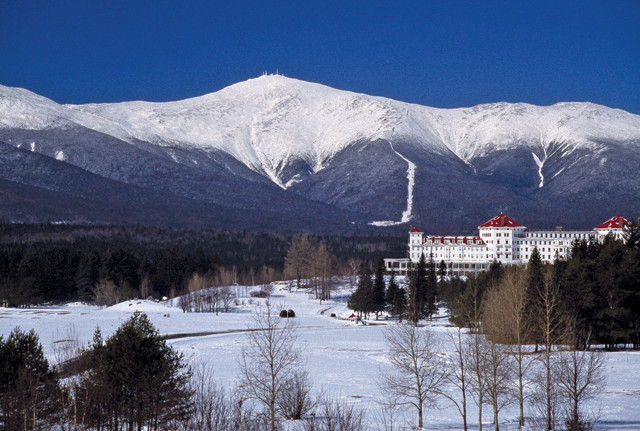
by Lucas Joel Tuesday, September 13, 2016

New Hampshire's Mount Washington, snowcapped in winter, is a part of the White Mountains in the northeastern United States. Credit: Library of Congress.
The mountains of eastern North America, like the Appalachians, Adirondacks and White Mountains, are old: They grew as the pieces of the supercontinent Pangea collided and assembled more than 300 million years ago. It’s been long thought that, after forming — and subsequently undergoing additional uplift and deformation due to rifting during the opening of the Atlantic Ocean — the mountains fell dormant between about 160 million and 200 million years ago. But new work is adding to a growing body of evidence suggesting the ranges were tectonically active well after that.
To some geologists, that these ancient mountains still exist is puzzling: “It doesn’t make any sense because the last compressional tectonics [were] roughly 300 million years ago, and the last extensional tectonics were about 200 million years ago,” says Will Amidon, a geologist at Middlebury College in Vermont and lead author of the new study in Geology. Even with some rifting-related uplift during the Jurassic, if there has been no compressional tectonism since the mountains first formed, weathering and erosion should have already mostly leveled the landscape, Amidon says. Yet, the tallest Appalachian peaks — like Mount Washington in New Hampshire’s White Mountains — still reach upwards of 1,900 meters. This raises the question, he says: “What has happened [tectonically] in the last 200 million years?”
“One way that we might identify tectonic events is by looking to see when rocks have cooled,” which they do as they rise to the surface, Amidon says. So he and his team turned to thermochronology, which relies on the regularity of radioactive decay and involves dating rocks by determining when they passed through a certain temperature.
Sampling a 910-meter-deep drill core taken from the White Mountains, Amidon and his team analyzed the decay of uranium and thorium into helium in grains of apatite. “When the [apatite] crystal is hot, the helium just … floats out and escapes,” he says, but when the mineral cools to about 65 degrees Celsius, the apatite starts retaining helium. By measuring the amount of retained helium in the White Mountain drill core apatites (the more helium there is, the longer ago the sample cooled), the team could then gauge how long it had been since the rock cooled to below the threshold temperature. They found that the rock in part of the drill core had “passed through about 65 degrees Celsius [starting] about 80 million years ago” at an accelerated rate, indicating a likely pulse of uplift that lasted until about 65 million years ago, Amidon says.
The new evidence for this pulse in the White Mountains is “not surprising, but it’s really interesting,” says Greg McHone, a retired geologist formerly of Wesleyan University who was not involved in the new work. Researchers have previously suspected that uplift had occurred around this time “because there’s an enormous amount of Late Cretaceous and Tertiary sediment collected along the East Coast offshore right along the edge of the continent,” he says. This sediment may have accumulated as adjacent mountain ranges were uplifting and as freshly exposed rock eroded and was carried away. However, these sediments haven’t provided detailed information about the timing and specific locations of such uplift.
With this pulse of Late Cretaceous uplift identified in more detail, another challenge is to understand why such activity along the eastern margin of North America happened at this time. The force that drove the uplift is still “a head-scratcher — there isn’t any clear idea about it,” McHone says.
Amidon says that “subtle tectonic processes,” like a change in mantle convection or in lateral stresses in the lithosphere, could have been responsible. He notes also that the uplift could have been driven, in part, by climate change causing increased weathering — and thus more rapid exhumation and rising — of fresh rock in the ancient mountains. More work is needed, though, he says, to “determine exactly what drove this pulse of exhumation and whether it was restricted to the White Mountains or affected a broader swath of the Appalachians.”
© 2008-2021. All rights reserved. Any copying, redistribution or retransmission of any of the contents of this service without the expressed written permission of the American Geosciences Institute is expressly prohibited. Click here for all copyright requests.